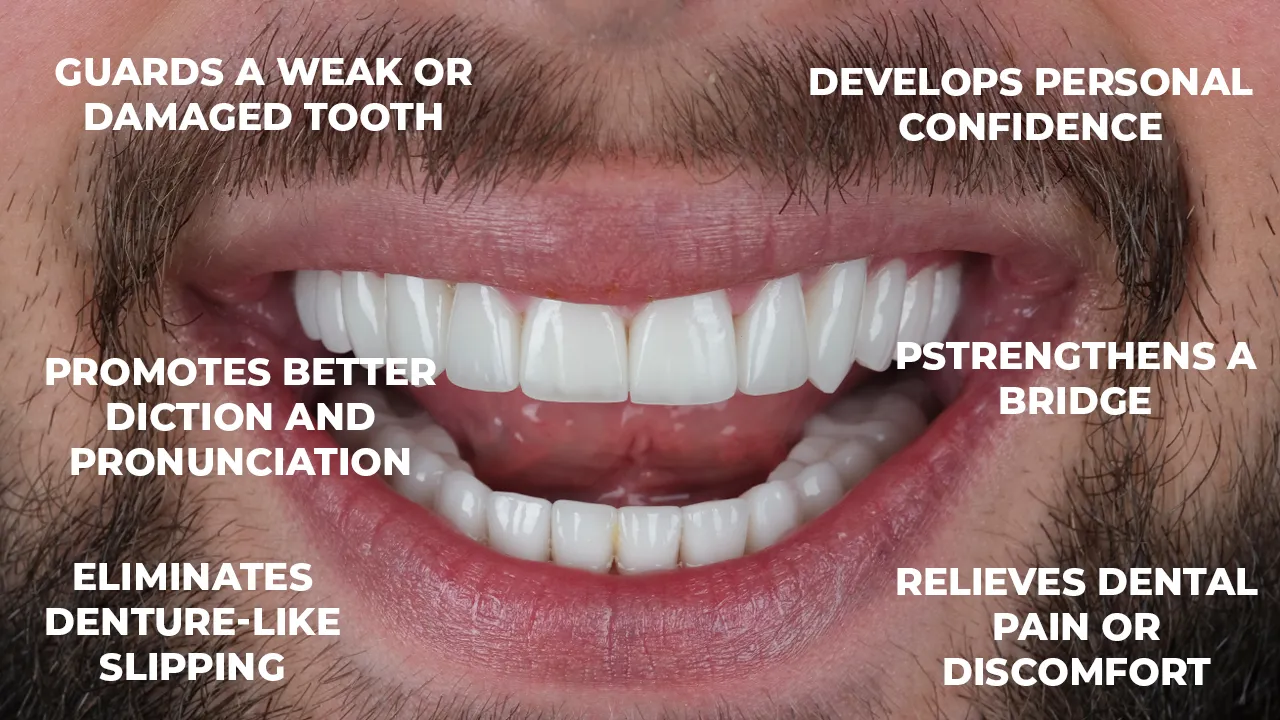The main types of dental crowns include porcelain, zirconia, metal (such as gold alloys), and resin, each with unique differences in appearance, durability, cost, and common uses.
Porcelain crowns offer the most natural, tooth-like appearance by closely mimicking enamel, making them ideal for visible front teeth. However, porcelain is slightly less durable than zirconia or metal options and can be more prone to chipping under heavy force.
Zirconia crowns are extremely strong – comparable in durability to metal – and resist cracking better than porcelain. They also provide a tooth-colored look, so zirconia is often chosen for molars or for patients who grind their teeth and need extra strength.
Metal crowns (including gold) have the longest lifespan and rarely chip or break, while requiring only minimal tooth preparation. The trade-off is their metallic color, so these crowns are usually reserved for out-of-sight back teeth, and gold crowns are also among the most expensive options.
Resin crowns (plastic composite) are the most affordable option and can be made to match the tooth color; however, they are the least durable, typically used as temporary solutions or budget-friendly short-term fixes.
When weighing these options, patients should consider aesthetics, longevity and cost – factors that can vary by location – and note that many people considering dental treatment in Turkey find high-quality porcelain or zirconia crowns available at significantly lower prices
Dental crowns are a globally recognised dental care that envelopes the entire problematic tooth. Dental crowns are capable of restoring the tooth's form, dimension, power, and look through a non-invasive process.
Dental crowns are essential for sustaining healthy oral status. They are vital in repairing the framework and purpose of compromised teeth, enabling clients to bite and eat effectively. Dental crowns assist in keeping teeth in proper alignment, preventing subsequent dental problems such as shifting or misalignment.
There are a lot of benefits to having dental crowns. Some benefits include tooth protection, dental strength and durability, oral aesthetics, tooth restoration, and longevity for the tooth. Dental Crowns act as a barrier to shield weak or worn-out teeth from further deterioration or damage. They are manufactured from strong materials that endure biting and chewing forces, such as porcelain, metal, or a mix of both.
Dental crowns are crafted to complement the inherent teeth's natural hue and form, enhancing the aesthetics of the smile. They allow patients to eat and speak comfortably by restoring the dimension, form, and purpose of worn-out teeth. Dental crowns endure for several years and provide benefits over time with the right maintenance and care.
Dental Crowns are associated with several downsides, similar to other dental restorations. Cost is one disadvantage. Dental crowns are pricey, especially if there are several damaged teeth involved. The tooth preparation for installing a dental crown is quite challenging which entails removing a sizable piece of the tooth's framework to cater for the crown.
Sensitivity is another downside to dental crowns. Some individuals are expected to feel sensitivity to hot or cold temperatures after installation. People are anticipated to experience allergic reactions to the components of the crown, in rare cases. Dental crowns have the potential to be damaged when subjected to severe force or impact, although they are reputed to be resilient.
Some main varieties of dental crowns comprise Zirconia Crowns, Metal Crowns, Porcelain Crowns, Porcelain-Fused-to-Metal or PFM Crowns, and All-Ceramic Crowns. Zirconia Crowns are made from a strong, tooth-coloured substance called Zirconia. Zirconias are known for their resistance to breakage and durability rendering them appropriate for the creation of dental crowns, and are normally utilised to repair teeth.
Metal crowns are renowned for their sturdiness and longevity and are composed of gold or silver alloy. They are used for molars and other teeth that demand a lot of foundation. Porcelain crowns are produced from ceramic, closely resembling the hue and luminescence of genuine teeth. Porcelain crowns are a great alternative for front teeth and are visually appealing repairs.
Porcelain-Fused-to-Metal (PFM) Crowns deliver endurance and attractiveness by fusing a porcelain upper layer with the resilience of a metal foundation. PFM crowns are employed on the front and back teeth and are adaptable. The All-Ceramic Crowns have all their components in ceramic substances, such as porcelain or lithium disilicate. Ceramic crowns are acceptable for patients with metal allergies and offer outstanding aesthetics.
1. Gold Crowns
Gold crowns or gold alloy crowns are dental crowns constructed of a combination of gold and other metals, such as copper and silver. Gold crowns have a long history of usage in dentistry and are renowned for their toughness and endurance.
Gold crowns are installed for people who need crown restoration on their back teeth, especially molars as they need a sturdy material to withstand the strain. Gold crowns are less utilised for front teeth due to their colour, which appears more noticeable than natural teeth.
The purpose of Gold crowns is to repair broken or decaying teeth. They have great structural stability and endure chewing and biting pressure. Gold crowns are renowned for their durability and longevity. They survive for many years when good oral hygiene is practised and dental care is consistent.
Gold crowns are biocompatible and hypoallergenic in terms of sensitivity. Most people do not experience serious sensitivity difficulties from them. People temporarily experience sensitivity after having a crown placed regardless of the material chosen.
The procedure for installing a gold crown requires two appointments to complete the process. The dentist shapes the tooth to accept the crown and remove any decay or damage during the initial appointment. The personalised gold crown is made using an impression of the tooth that is sent to a dental laboratory. A temporary crown is affixed to the prepared tooth while the permanent one is being created. The gold permanent crown is bonded or cemented onto the tooth in the second session after the temporary crown has been removed.
The price of gold crowns varies depending on many variables, including the area, the case's complexity, the dentist's costs, and any extra treatments needed. Gold crowns normally cost more than other types of dental crowns, due to the cost of the materials used. The cost for gold dental crowns with a private dentist is approximately £513.30 in Turkey, but it varies if the gold price fluctuates in the market. It costs about half of that amount if done with NHS-certified or National Health Service facilities.

2. Porcelain Crowns
Porcelain crowns or ceramic crowns are restorations for the teeth consisting of porcelain. Porcelain crowns provide an aesthetic alternative to achieving radiant grins by utilising a genuine-appearing material.
Porcelain crowns are suitable for people who need a crown restoration on their visible teeth or front teeth. They are chosen by most patients because they produce a genuine-appearing grin by accurately mimicking the colour texture and translucency of real teeth.
The purpose of porcelain crowns is to repair and shield teeth that have suffered severe damage, decay, or root canal therapy. Porcelain crowns offer both functional and aesthetic advantages by strengthening, reshaping, and enhancing the tooth's look.
Porcelain crowns typically have a strong and enduring quality. Porcelain crowns are thought to be more prone to chipping or fracturing under severe force or trauma compared to other crown materials, particularly gold or zirconia. They normally last between 10 and 15 years with good oral hygiene and routine dental treatment, sometimes even longer.
Porcelain crowns are reported to have low sensitivity levels. Porcelains do not create serious sensitivity, difficulties, or allergic reactions in dental patients. Know that the tooth below the crown is still sensitive if there is an underlying dental condition.
There are two dentist appointments required for the porcelain crown installation process. The dentist prepares the tooth during the first appointment by removing any disease or damage and moulding a healthy copy of the tooth. A temporary crown is put in place while the permanent crown is being created. The actual porcelain crown is inserted into the tooth at the second appointment after removing the temporary crown.
The cost of porcelain crowns depends on the geographic area, the intricacy of the case, and the dentist's competence. Porcelain crowns cost £140 in Turkey. NHS pricing for porcelain crowns is most expensive and involves long waiting periods and patient queues.

3. Stainless Steel Crowns
Stainless steel crowns are a particular form of dental restoration created from stainless steel. Stainless steel crowns are mostly utilised in paediatric dentistry, especially for young patients with severe tooth decay or injury.
Children who need orthodontic treatment on their main baby teeth are advised to use stainless steel crowns. Stainless steel crowns are preferred by most parents for their babies as they are affordable, simple to install, and excellent at protecting baby teeth until they naturally fall out.
The purpose of stainless steel crowns is to repair and shield primary teeth that have experienced root canal therapy, severe fracture, or extensive decay. Stainless steel crowns offer a sturdy and dependable covering for the afflicted tooth, eliminating further decay and enabling the tooth to operate normally.
Stainless steel crowns are strong and long-lasting. They are created specifically to endure the stresses of biting and chewing in the first dentition. Stainless steel crowns remain in place until the primary tooth naturally falls out in children.
Crowns made of stainless steel have low levels of sensitivity. Most children tolerate the biocompatible stainless steel material well but, temporary sensitivity is expected to occur after a crown is placed. Sensitivity is experienced when the involved tooth previously had damage.
The installation of stainless steel crowns takes a short amount of time and requires just one dental visit. Any decay or damage in the target tooth is first removed and the tooth is shaped afterwards to match the crown. Dental cement is used to fit the stainless steel crown over the tooth and hold it there. Children often endure the operation well.
Stainless steel crowns are stainless steel caps that are cheaper to purchase compared to other dental covering varieties, making them ideal for paediatric dentistry. Stainless steel crowns cost £100, excluding any related treatments or procedures in Turkey. The precise price changes depending on the location, the dentist's costs, and any extra procedures needed.

4. Titanium Crowns
Titanium crowns refer to dental crowns that are titanium-based or incorporate titanium as a foundation for the crown. Titanium is not employed as a sole material for dental crowns, although it is utilised in dental and medical applications. Dental crowns with titanium bases belong to the family of metal crowns and are better coined as Titanium-supported crowns. The titanium base is covered in a different material, such as porcelain or ceramic, for aesthetic purposes.
People who have metal allergies or require dental crowns in locations where there is not enough room for a full ceramic or porcelain crown are suitable to utilise titanium-supported crowns.
The purpose of Titanium-supported crowns is to provide robust and aesthetically pleasing dental restorations. The exterior layer of porcelain or ceramic delivers a natural-looking appearance that complements the neighbouring teeth, while the titanium substructure offers great longevity and resistance to fracture.
Titanium-supported crowns are renowned for their strength and resistance to fracture in terms of durability. Titanium is a strong, biocompatible material used for dental restorations. The durability of such crowns is affected by some factors such as hygiene routines, occlusal stresses, and individual conditions.
Crowns that are supported by titanium have low levels of sensitivity due to titanium's biocompatibility to the human body. Additional factors including the health of the gums and teeth beneath the surface impact the person's level of sensitivity.
The degree of complexity of the case, the number of teeth involved, and the exact treatment plan affect how long it takes to place titanium-supported crowns. Multiple dental appointments are required for the operation, which includes shaping the tooth, taking impressions, and attaching the final crown to the titanium substructure.
Titanium-supported crown prices vary based on the location of the patient, the intricacy of the case, the dentist's costs, and any extra procedures needed. Metal-to-porcelain crowns, such as titanium-supported crowns, cost £200 in Turkey.

5. Resin Crowns
Resin crowns pertain to a type of dental crown constructed of a composite resin material that is tooth-coloured. Resin crowns are referred to as composite crowns which offer a cosmetic option for people looking for a visually pleasing repair. Resin crowns match the colour of the teeth, making them a preferred dental restoration for certain patients.
Resin crowns are suitable for people needing crown restorations on their visible teeth or front teeth. Resin crowns offer a high value on aesthetics that closely resembles a natural-looking tooth.
The purpose of resin crowns is to repair broken or decaying teeth while shielding them from further damage. They offer both functional and aesthetic advantages by improving the tooth's shape, strength, and appearance.
Resin crowns are not as strong as certain other crown materials, such as metal or porcelain, in terms of durability. Resin crowns are more prone to wear and cracking over time, especially when subjected to extreme biting forces or grinding habits. They normally last between five and ten years. Resin crowns sometimes need to be replaced more frequently than other types of crowns.
Crowns made of resin have low levels of sensitivity. The composite resin employed is biocompatible and generally well-tolerated by people. Sensitivity takes place if there are unresolved dental problems involving the tooth or if the tooth experienced damage or decay before.
The procedure for resin crown placement requires two dental visits. The tooth is prepared during the initial session by getting rid of any decay or damage and moulding it to fit the crown. A temporary crown is affixed while the permanent one is being created. The permanent resin crown is attached to the tooth during the second appointment after the temporary crown has been removed.
Resin crowns are less expensive than other crown materials such as porcelain or metal. Resin crowns are considered the least expensive ones, but they are the most vulnerable to breaking. Prices for resin crowns are £60 per tooth in Turkey.

6. Porcelain and Metal Hybrids
Porcelain and metal hybrid crowns pertain to dental restorations that combine metal and porcelain in one crown. Hybrid crowns are known as porcelain-fused-to-metal or PFM crowns, whose structure is characterised by a metallic foundation beneath the crown and a porcelain covering atop. The porcelain layer replicates the natural appearance of teeth while the metal foundation offers strength and stability.
Porcelain and metal hybrid crowns are applicable for people who need a dental procedure which includes durability and aesthetics. Hybrid crowns are utilised for both the front and back teeth. The purpose of hybrid crowns is for the restoration and protection of decayed or damaged teeth. They offer a harmony between durability and beauty that appears natural on aesthetically revived teeth.
Hybrid crowns made of metal and porcelain are sturdy and long-lasting, but the porcelain coating becomes worn or damaged over time, especially if it is subjected to forceful biting or grinding practises. Hybrid crowns normally endure for 10 to 15 years or longer with good oral hygiene and routine dental maintenance.
Hybrid crowns made of metal and porcelain often have minimal levels of sensitivity. Hybrid crowns are biocompatible and well-tolerated by most patients. Sensitivity is expected to occur due to unresolved dental problems.
The process for installing hybrid crowns takes two dentist visits. The tooth is prepared during the initial session by getting rid of any decay or damage, moulding it to fit the crown, and affixing a temporary crown while the permanent one is being created. The permanent porcelain and metal hybrid crown is bonded or cemented onto the tooth at the second visit after the temporary crown is removed.
The price of porcelain and metal hybrid crowns is affected by the area in which they are placed, the difficulty of the case, the dentist's costs, and any extra procedures necessary. PFM crown cost £140 in Turkey. Hybrid crowns cost between mid-to-high prices when compared to other dental crowns.

7. Temporary Crowns
Temporary crowns refer to short-term dental restorations used on prepared teeth while the permanent crown is still being created in a dental lab. Temporary crowns are named provisional crowns, created from composite resin.
People who have had their teeth prepared for a permanent crown are advised to have temporary crowns since they require a short-term remedy to shield the prepared tooth. The process provides functional and aesthetic benefits while waiting for the final crown.
The purpose of temporary crowns is to preserve the integrity of the prepared tooth, avoid sensitivity, offer protection, and restore the fundamental function and appearance of the tooth. Temporary crowns are installed during the interim period before the permanent crown is affixed.
Temporary crowns are not as sturdy as permanent crowns in terms of durability. Temporary crowns are prone to break or deteriorate because they are not designed to sustain prolonged use. They are made to endure for a few weeks or months depending on the particular instance and the fabrication period for the permanent crown.
Temporary crowns do not increase a person’s sensitivity as they perform comfortably as expected. Remember that there are minimal and transient sensitivity or pain is expected to occur while they are in place.
The process for temporary crown installation is straightforward and is completed in just one dentist appointment. A temporary crown is created, and worn to the tooth, and an impression of the prepared tooth is obtained following tooth preparation.
Temporary crowns are free, and some dental clinics include them in the total fee of the treatment in Turkey. Prices differ depending on the type of crown the patient wants to have, whether it be porcelain crowns, metal crowns, or PFM crowns. Other factors that affect the cost of temporary crowns include geographic area, the difficulty of the case, the dentist's fees, and any additional treatments required.

8. Ceramic Crowns
Ceramic crowns, known as all-ceramic caps or porcelain crowns, are dental prostheses predominantly manufactured from ceramic materials. Ceramic crowns are meant to precisely replicate the look of inherent teeth, providing an aesthetic answer for patients who prefer a restoration that fits smoothly with their smile.
Ceramic crowns are suitable for individuals who necessitate cap replacements for their primary teeth. The objective of ceramic crowns is to treat damaged or rotting teeth and protect them from further deterioration. They give both practical and cosmetic benefits by increasing the tooth's durability, form, and appeal.
Ceramic crowns are durable and are capable of enduring regular biting and chomping activities, while they are not as strong as certain materials, such as metal or zirconia. Ceramic crowns endure for 10 to 15 years or more, with good oral hygiene and routine dental care. Ceramic crowns are noted for their low sensitivity levels. The ceramic material utilised in such crowns is biocompatible and well-tolerated by the majority.
The technique for putting ceramic crowns normally comprises two dental appointments.
The first visit involves preparation of the affected teeth which includes cleaning, moulding, and inserting the temporary crown. The second visit entails the actual installation of the permanent ceramic crown.
Ceramic crowns are often in the mid-to-high price range in comparison to other substitute dental caps due to their aesthetic appeal and customisation. The cost of ceramic crowns in Turkey is £240 per tooth.

9. Zirconia Crowns
Zirconia Crowns are another common type of dental caps made of zirconium dioxide, a highly durable ceramic substance. Zirconia crowns are known for their natural-looking appearance, strength, and virtually indestructible features.
Zirconia crowns are appropriate for people who need a crown on areas with significant bite pressures, particularly the molars. The crowns provide a natural-looking repair and are suitable for people who are seeking a metal-free restoration. The primary aim of zirconia crowns is to restore a tooth that has been injured, decayed, or fractured to its former form and functionality. They keep a tooth safe following a root canal procedure, serving as a support for dental bridges.
Zirconia crowns endure anywhere from 15 to 20 years on average. Their survival is affected by the patient's oral cleanliness, habits such as teeth grinding, and the frequency of their dental examinations. Zirconia crowns have lower sensitivity levels than other materials. Patients are less prone to experience temperature sensitivity because zirconia is not a good conductor of heat or cold.
The procedure for a zirconia crown is normally completed within two visits to the dentist. The first appointment approximately lasts 1 to 2 hours, during which the dentist removes decay from the involved tooth and shapes it. An image or digital scan of the prepared tooth is obtained and sent to a dental lab to be custom-made. A temporary crown is placed on the tooth until the permanent crown is ready.
The second visit takes about 30 minutes to 1 hour, typically 1-2 weeks after the first consultation. The dentist fits the completed crown into the shaped tooth and cements it into place. Changes are made until a comfortable bite is achieved.
Zirconia crowns are now viable to be installed in one visit, due to continuous improvements made on the procedure. The dentist first examines the mouth, takes digital photographs, and prepares the tooth for the operation, which entails local anaesthetic administration. The digital scan of the images is utilised to build the final crown inside the facility.
A computer-aided design/computer-aided manufacture (CAD/CAM) technology is used to aid the CEREC or Chairside Economical Restoration of Aesthetic Ceramics process. The crown is created by the dentist using a dental milling machine from a block of zirconia. It is later set in place with cement.
Zirconia crowns in Turkey typically cost around £210. The pricing is primarily affected by the geographic location. The expertise of the dentist, the complexity of the procedure, and the overhead costs of the dental clinic influence the price of such crowns. Some insurance policies cover a portion of the procedure, depending on the plan and the reason for the crown. Speak with a local dentist for specific cost estimates.

What is a Dental Crown?
A dental crown is a cap or covering that encases the whole tooth surface, returning it to its previous shape and size. Dental crowns are made of porcelain, ceramic, metal, or a combination of such materials. The crowns serve both utilitarian and decorative reasons. They give broken, decaying, or cracked teeth strength, allowing them to tolerate the forces of chewing and biting.
Dental crowns are an important tool for salvaging teeth that are supposedly pulled away. Crowns substantially improve the appearance of teeth by concealing pigmentation, imbalances, or other cosmetic defects. They are colour-matched to the patient's neighbouring teeth for a more realistic appearance.
A dental crown is normally obtained after two visits to the dentist. The tooth is prepped for the crown on the first visit by eliminating the decaying materials in the tooth and re-shaping its surface. An impression is taken to create an accurate mould for crown manufacturing after that. A temporary crown is utilised while the permanent crown is created. The custom-made crown is cemented onto the prepared tooth during the second session. A Dental Crown lasts for many years if properly cared for, providing patients with improved oral function and a restored smile.
How Important is a Dental Crown?
A dental crown is important as it is used in various dental procedures. Dental crowns are among the most preferred current dental restorative techniques, allowing a prosthesis to copy the top section of the tooth. Crowns safeguard the tooth by covering its entire structure above the gum line. A dental crown restores the tooth's function and appeals whether it is damaged, has an aesthetic issue, or is infected.
A crown dramatically improves one's smile and builds confidence by delivering a tooth with a proper form, size, and colour. A smile is important for self-esteem and interpersonal connections, and a crown allows people to grin without feeling self-conscious.
Dental crowns provide an advantage in terms of functionality, particularly with eating. A damaged tooth makes eating, a fundamental human activity, uncomfortable or ineffective. A crown restores a tooth's complete chewing function, allowing an individual to keep enjoying their food and retain optimum nutrition.
One of the most important functions of a dental crown is tooth protection. Teeth that are broken, decaying, or weaker are more vulnerable to further injury or infection. A crown works as a shield, protecting the tooth from outside influences and limiting further damage or extraction. Dental crowns are essential tools for preserving oral health since they ensure both the operation of the mouth and the beauty of a smile.
Crowns are often chosen for their ability to fully cover and protect a damaged tooth, while bridges are typically used to replace one or more missing teeth by anchoring to adjacent teeth, making it important to understand the differences between crowns vs bridges.
Which Dental Crown Type Lasts Longer than the Regular One?
The dental crown type that lasts longer than the regular one is the Metal Crown. Metal crowns are recognised for their extraordinary durability, and are frequently constructed from alloys incorporating gold or base metals such as palladium. Their toughness prevents them from quickly chipping or fracturing, distinguishing them from other types of crowns that are more prone to such damage. They often outlast their porcelain or composite competitors in terms of lifespan, making them a long-term alternative for dental restorations.
The minimum dental enamel reduction necessary after a metal crown insertion is a significant advantage, maintaining more of the native tooth structure. Their main disadvantage is their noticeable metallic colour, which is not preferred by individuals who value a natural tooth appearance. Their robustness and endurance make them a good choice for molars, usually hidden from view and must withstand large chewing forces.
Which Dental Crown Type is the Most Expensive?
The dental crown type that is the most expensive is the Zirconia Crown. Zirconia crowns command the highest pricing, with expenses amounting to £210 in Turkey. The excellent properties of zirconia account for their expensive value, being the most durable ceramic available for dental uses.
The substance is made of a durable ceramic, with a strength comparable to that of titanium. Zirconia is ten times stronger when compared to natural enamel demonstrating its greater lifespan and wear resistance. Zirconia crowns are additionally appealing. Zirconia's composition allows it to mirror the way natural teeth react to light, reflecting it in a manner akin to real enamel or traditional porcelain. The restoration fits in seamlessly with the surrounding teeth, producing a smooth and natural appearance.
Zirconia's intrinsic qualities make it biocompatible as it is completely metal-free, removing concerns about potential allergic reactions. They usher a conservative tooth preparation and effectively fasten to the patient's existing tooth structure.
Which Dental Crown is Very Sensitive?
The dental crown type that is very sensitive is the Temporary Crown. Temporary crowns are transitory dental treatments that usually exhibit increased sensitivity as compared to permanent counterparts. One cause of the sensitivity is their less perfect fit, which exposes sections of the dentin, the inner layer of the tooth. Dentin is permeable by nature, with tubules that interact straight with the tooth's inner nerve.
Stimuli such as food, liquids, or even air easily reach such tubules when the layer is exposed. The patient is expected to experience increased sensitivity or even discomfort as a result of the direct nerve stimulation. Temporary crowns are capable of causing greater sensitivity until a permanent crown is put on.
Which Dental Crown Looks Natural?
The dental crown that looks natural is the Porcelain or Ceramic Crown. Porcelain and zirconium-based materials have emerged as top alternatives in dental restorations, notably in the creation of crowns that exude beauty, authenticity, and durability. Their growing popularity is due to their ability to effectively combine functionality with aesthetics. Many people do not want to jeopardise the natural look of their teeth in the pursuit of dental wellness. Zirconia and porcelain crowns are particularly applicable in such a regard.
Zirconia is diligently adjusted to match the specific hue of porcelain chosen by the patient, ensuring a flawless merge with neighbouring teeth. The absence of the metallic tint is a significant advantage of zirconia crowns. Metallic colouration typically emerges around the gumline or neighbouring teeth, a usual problem associated with conventional metal-based or metal alloy crowns.
Porcelain is a little more delicate than other options, despite its incredible ability to mimic the translucency and gloss of actual teeth. It is frequently advised for teeth with porcelain crowns to now indulge in strenuous chewing or grinding pressures, ensuring both longevity and aesthetics of the crown.
What are the Benefits of Dental Crowns?
The benefits of dental crowns are listed below.
- Creates an appealing tooth shape and colour: Dental crowns are precisely crafted to closely resemble the natural look of the teeth, resulting in a visually appealing result. Crowns blend in with one's smile by matching the tint of neighbouring teeth, making dental work nearly invisible. They effectively conceal discoloured, deformed, or chipped teeth, giving the patients a more youthful appearance. The restoration considerably improves the general appearance of one's mouth.
- Guards a weak or damaged tooth: Dental crowns serve as a shield, encasing fragile teeth that have been weakened by disease, cracks, or recent dental treatments. The enamel of the tooth is incapable of growing back once it is damaged. Most damages done to the teeth do not heal on their own. Dental crowns give structural strength by encircling the tooth, avoiding additional deterioration or potential tooth loss. They are especially important for teeth that have had root canal treatments since they protect them from external forces and potential infections.
- Promotes better diction and pronunciation: Teeth are important in articulation and the creation of specific sounds. Speech is distorted by missing or malformed teeth, resulting in confusing pronunciation. A dental crown helps to correct speech problems caused by dental disorders by correcting the form and position of such teeth. It improves diction, clarity, and communication abilities over time.
- Develops personal confidence: A bright smile has a significant impact on one's self-esteem and social relationships. Dental insecurities, whether caused by discolouration or injury, make it difficult to smile or talk freely. Dental crowns boost people's confidence by restoring the strength and visual appeal of their teeth. A restored grin provides a psychological boost that improves one's general well-being and social ease.
- Strengthens a bridge: A dental bridge is a prosthetic tooth placed between two real teeth held by dental crowns. Dental bridges, which are used to replace lost teeth, rely primarily on the support of neighbouring teeth. Crowns give the adjacent teeth a solid base for the bridge. It guarantees that the bridge maintains a secure position, that biting forces are distributed equally, and that it performs at the optimum level. The capped teeth serve as anchor points for the bridge, increasing its endurance and efficiency.
- Eliminates denture-like slipping: Many people prefer a collection of crowns over traditional dentures as they inevitably slip out of place. Dental crowns assist in anchoring partial dentures or dental implants more firmly. Crowns improve the stability of such dental treatments by avoiding unwanted movement or slippage. It results in a more comfortable fit, less gum irritation, and a bite that feels more natural. The wearer has a more dependable, worry-free dental prosthetic experience.
- Relieves dental pain or discomfort: Decaying or damaged teeth sometimes cause substantial discomfort or sensitivity. Dental crowns operate as a barrier against irritants such as high temperatures or sugary foods that aggravate discomfort by enclosing the damaged tooth. Crowns relieve discomfort and restore a pain-free dental experience by resolving the underlying condition and providing a protective covering. The solution allows people to eat, drink, and go about their regular lives without fear or agony.

What are the Downsides of Dental Crowns?
The downsides of dental crowns are listed below.
- Incurs high expenses: Dental crowns, especially the ones manufactured of high-quality materials, are an expensive investment. The average cost for dental crowns ranges from £140 to £300 in Turkey. The prices get higher in other places in Europe and the UK, not to mention the kind of crowns and methods associated. They provide long-term benefits but the initial expense is relatively too expensive for many patients, particularly if numerous crowns are required. Not all insurance policies cover the whole cost of dental crowns, forcing patients to bear a significant percentage of the cost. Potential replacements or revisions add to the total cost over time.
- Associate sensitivity and pain: Sensitivity and discomfort in a crowned tooth are usual following the surgery when the anaesthesia wears off. Some people report sensitivity after receiving a dental crown, particularly to hot or cold stimuli. The sensitivity is caused by exposed dentin or the crown's closeness to the dental nerve. The soreness is upsetting for patients in the short term, but it usually goes away with time. Brushing one's teeth using a toothpaste designed specifically for sensitive teeth helps to alleviate such irritation. Pain persists, indicating that there is a problem with crown placement or fit. Visit the dentist right away since they simply know the remedy for such discomfort.
- Demands potential follow-up repairs: Dental crowns are built to last, but, they are not indestructible. Chipping, loosening, or full dislodgement are still viable to occur, especially if the bite force or damage is considerable. A dental crown, particularly one composed of porcelain is anticipated to chip with time, even when placed above a chipped tooth. A little chip in a dental crown is fixed while the crown is still in the mouth, but the dental crown must be replaced with a major chip or a series of small chips. The cement used to keep the crown over the tooth has the potential to wash out from beneath the crown over time, causing the crown to become loose. A loose crown permits bacteria to enter and induce decay in the rest of the tooth. The crown normally falls off due to a shortage of cement or an incorrect fit of the crown over the tooth. Re-cementing the crown or constructing a new crown if the old crown is irreplaceable are viable ways to resolve the issues. Return to the dentist when such situations occur, for repairs or replacements. There are multiple potential modifications over the life of a crown, adding to the entire care effort.
- Includes risk for nerve injury: A danger of nerve injury occurs when the dentist drills near the pulp chamber during the tooth preparation process for crown implantation. The risk causes extreme discomfort or perhaps destruction of the tooth nerve, prompting root canal therapy. Nerve damage causes long-term suffering and necessitates more intrusive surgeries to correct the condition. Dental practitioners must use extreme caution throughout the preparatory process.
- Causes oral infection: Microorganisms invade the underlying tooth and cause illness when a dental crown is not properly placed or has a gap in its seal. The infections are painful, resulting in the formation of an abscess, and demand treatments such as root canal therapy or even removal of the tooth. Correct positioning and periodic dental examinations are required to detect and treat any indications of infection promptly.
- Triggers Allergies: Allergic reactions to dental crowns are relatively uncommon. Certain crown materials cause allergic reactions in people who are sensitive to them, particularly the ones based on metal. Localised gum irritation to more widespread effects are potential signs. Patients must address any known metal sensitivities with their dentist before crown implantation. Choosing hypoallergenic materials such as ceramic or zirconia helps alleviate such concerns.
How Do Dental Crowns Perform Compared to Veneers?
Dental crowns perform compared to veneers in several considerations. Dental crowns and veneers improve the look and capability of teeth but pose significant distinctions in terms of their uses, processes, and characteristics.
The biggest distinction is in their scope. Dental crowns wrap the entire tooth, forming a cap that protects the chewing surface, front, and back of the tooth. Veneers simply shield the front surface of the tooth, acting as a thin shell to enhance its look.
Dental crowns are utilised to restore teeth sustaining serious decay or have had root canal therapy. They offer structural support for the tooth, assuring its endurance and usefulness. Veneers are mostly aesthetic treatments, perfect for correcting concerns such as discolouration, tiny chipping, or minor displacement. Crown preparation necessitates more dental structure removal than veneer preparation. Veneers require minor enamel scraping from the tooth’s front surface, whereas crowns require contouring or decreasing the tooth to cater the cap.
Dental crowns and veneers are both enduring, however, crowns deliver more powerful protection since they encircle the whole tooth. Veneers, despite their strength, are more prone to chipping or flaking off, especially if subjected to severe force or incorrectly bonded. The price of such prostheses varies greatly, although crowns are often more pricey than veneers owing to the supplies utilised and the superior protection they deliver.
Evaluating one's dental condition at hand, the intended goal and the practitioner’s call are vital when choosing between dental crowns or Dental Veneers.
How Do Dental Crowns Perform Compared to Onlays?
Dental crowns perform compared to onlays through several factors. Dental crowns and onlays are both restorative dental procedures, however, their applications, depth of coverage, and usage scenarios differ.
Dental crowns are artificial caps that extend from the gum line to the chewing surface of the tooth. They are intended to completely enclose the tooth, restoring its size, function, and shape. Onlays, termed "partial crowns," are less invasive than full crowns. They are intended to cover and restore just a piece of the tooth, especially when the damage is insufficient to justify a full crown but is too severe for an ordinary filling.
Crowns are often advised when a tooth has considerable structural damage, such as decay, fractures, or following root canal procedures. They restore the entire tooth's structure and functionality. Onlays are appropriate for circumstances in which the tooth's tip is injured or needs additional support without completely encasing the tooth.
Onlays preserve more of the existing tooth structure, while a crown requires the entire tooth to be reduced to accommodate the cap, an onlay simply involves modification of the afflicted area. Dental crowns and onlays are long-term remedies, however, complete crowns provide greater defence from subsequent decay or injury because of their extensive coverage.
Onlays are cheaper compared to full crowns since they require less material and, in many cases, less rigorous preparation. The decision between dental crowns and Onlays is determined by the individual dental issue, the amount of good tooth structure remaining, and the professional's suggestion.
Do Dental Crowns Need Abutments?
No, dental crowns do not need abutments. Abutments are used exclusively in dental implantology. An abutment connects the dental implant which is fixed into the jawbone to the crown, when a patient receives a dental implant. The abutment serves as a strong foundation or platform for the crown to be cemented or otherwise fastened to.
The tooth acts as its own "abutment," being prepared, sculpted, and shrunk to suit the crown. A dental crown is placed directly onto a natural tooth rather than an implant. The crown is subsequently cemented or glued straight to the prepped natural tooth, with no additional connecting piece required.
The term 'abutment' additionally applies to the supporting teeth on both sides of a dental bridge. Bridges have crowns affixed to the teeth used as an Abutment, which keep the bridge and its prosthetic teeth in place.
Are Dental Crowns Worth It?
Yes, dental crowns are worth it. Dental crowns are essential in restorative dentistry as they protect and reinforce problematic teeth. They replenish the tooth's functionality, allowing people to eat and talk without pain or difficulty.
Crowns improve one's looks by concealing discoloured or malformed teeth and increasing confidence. They provide a protective barrier to weakened teeth, safeguarding patients from more invasive operations or tooth loss in later years. Dental crowns are a wise investment for a lot of people due to their endurance and advantages to oral health and aesthetics.





